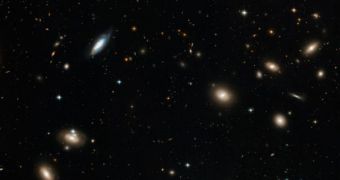The Coma Cluster, or Abell 1656, is a spherical galactic cluster about 20 million light years across located at about 300 million light years towards the north pole of the Milky Way, meaning it is relatively easy to view from Earth since the dust and gas plane of the galaxy doesn't interfere. The cluster contains several thousand galaxies, most of which are either elliptical or dwarf galaxies. The central region of the cluster contains an unusual high number of elliptical galaxies, with old populations of stars that give them a golden brown color.
The image featured here was captured by Hubble's Advanced Camera for Surveys and shows a portion of the Coma Cluster spanning over a couple of million light years. Several spiral galaxies are found towards the outer regions of the cluster, actively creating young stars out of the cold clouds of gas and dust inside, giving them a bright blue appearance.
Other galaxies, such as S0 ones, are structures evolved from spiral galaxies to elliptical galaxies, although they haven't gotten there yet so they still present some kind of star formation inside and a structure bearing a rough resemblance to their progenitors, usually a bar or a ring remnant of the original galactic disc.
The image taken by Hubble presents one spiral galaxy, in bright blue, while all the galaxies surrounding it have long passed their youth. Some of the reddish feature of one of the spiral arms of the spiral galaxy indicates that it might have interacted with it at some point in time. This particular image shows a couple of galaxies located at a distance of about one-third away from the center of the cluster.
The new observations will certainly contribute to the studies regarding the formation and evolution of galaxies, by comparing the environments of different galaxies, whether they are located in more dense or isolated areas of the space, and galaxies that are either closer to our own in terms of age, or some belonging to the early universe.

 14 DAY TRIAL //
14 DAY TRIAL //